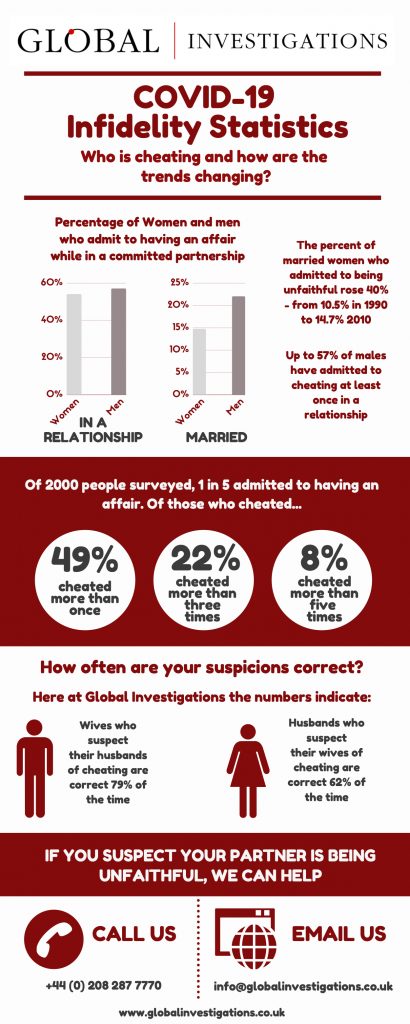Infidelity is one of the most commonly cited reasons for divorce in the UK according to the Office of National Statistics – but who is doing it and how are the trends changing?
During the COVID-19 pandemic, the experienced private investigators‘ team at Global Investigations have put together an infographic that shows the statistics on infidelity in marriage and relationships across the UK.

Do Men Cheat More Often Than Women?
Both men and women are equally capable of having an affair, although when most people hear the word ‘cheater’, they tend to picture a man. Historically, it may have been more likely that men were unfaithful, however, this trend is rapidly changing.
The percentage of married women having affairs rose almost 40 per cent from 1990 to 2010 reaching 14.7%, while the number of men admitting to extramarital affairs held constant at around 22%, according to data from the National Opinion Research Centre’s General Social Survey .
Although the infidelity statistics in the UK show the percentage of men having affairs while married remains higher, in unmarried relationships, males and females are now engaging in infidelity at similar rates . A 2017 study found that 57% of males and 54% of females admitted to committing infidelity in one or more of their relationships .
These numbers all depend on whether people are willing to tell the truth about their infidelity, but it is clear that both genders have the ability to cheat on one another.
Is It True That Once a Cheater, Always a Cheater?
Is this old saying true? In a survey performed by YouGov for The Sun newspaper regarding infidelity statics in the UK, one in five British adults admitted to having had an affair. Of those who have had an affair, only half have stopped at one. 20% have had three or more and 8% have had five or more . These infidelity statistics may paint a worrying picture if you know your partner has cheated before.
How Do People Meet Those They Cheated With?
In a poll of 2,000 of its customers, Superdrug found that more than 30% of cheaters have done so with a friend . At work was the next most popular setting, with another third of respondents saying that they met someone with whom they cheated with in the workplace .
Of course, social media was another popular place to connect with new partners, with 20% of users admitting to meeting and cheating with someone they met online . This encompasses both dating apps as well as avenues such as Facebook where people are able to reconnect with exes or old friends. In the UK in 2012, UK divorce site Divorce-Online found that one in five divorce petitions submitted to its database contained the word Facebook .
What Behaviours to Look out for?
Behaviours of cheaters tend to be associated with changes in normal behaviours and routines. Below are five of the most common signs of cheating :
- 1. Changes in intimacy: A marked change in intimacy or affection levels may indicate infidelity.
- 2. Secretive phone habits: A partner that hides or is protective of his or her phone or is secretive about their call logs and text messages is a common sign of infidelity. Some studies have noted that up to 60% of people surveyed have said a text message incriminated a spouse or aroused suspicion that a partner was cheating .
- 3. Suspicious internet use: Similar to phone habits, a partner who is overly secretive about general internet and computer habits can indicate infidelity.
- 4. Changes in work routine: A partner who is suddenly constantly working late or attending business functions and conferences can be a worrying sign.
- 5. Changes in grooming habits: A spouse that showers right when they get home, changes their style of dress, or changes their grooming habits can be a sign of cheating.
If you want to know more about what to look out for, check out our article on the 5 potential signs your partner may be cheating on you.
How Does a PI Catch a Cheating Partner?
Investigations will vary based on your wants and needs however, many times an investigation to catch a cheating spouse will include:
- 1. Discussion with the client – Before beginning an investigation, a private investigator will gather as much information as possible about the person in question. The more information you can share such as their regular activities and schedule, the more successful the investigation is likely to be.
- 2. Surveillance – A private investigator surveys your partner using advanced surveillance methods to ensure that you obtain the evidence you need. These methods may include surveillance of your partner’s home or office, following them from one location to another, attending the same events, or tracking your partner’s vehicle.
- 3. Evidence – Evidence gathered by a professional private investigator can provide indisputable proof such as photographic or video evidence of any indiscretions they might witness or may give peace of mind that no such behaviour was seen or the client may be presented with a report detailing the subject’s movements and interactions.
If you would like to find out more, read our article about how to catch a cheating spouse.
These UK infidelity statistics can be worrying and the suspicion that your spouse may be cheating is a painful thought. According to the Affairs of the Heart cases dealt with here at Global Investigations, wives who suspect their husbands of cheating are correct 79% of the time, while husbands who suspect their wives of cheating are correct 62% of the time.
These statistics are in line with other investigators and unfortunately show if you have a suspicion that your spouse is unfaithful, you may be right.
If you feel your partner is cheating on you and you want proof or peace of mind, we are here to help. Call us now on 02082877770 or get in touch via email at info@globalinvestigations.co.uk.
References
- O. o. N. Statistics, “Divorces in England and Wales: 2018,” 2018. . Available: https://www.ons.gov.uk/peoplepopulationandcommunity/ birthsdeathsandmarriages/divorce/bulletins/divorcesinenglandandwales/ 2018#unreasonable-behaviour-was-the-most-commonly-used-ground-for-divorce-by-both-opposite-sex-and-same-sex-couples.
- N. O. R. Centre, “General Society Survey,” . Available: http://gss.norc.org/get-documentation/social-change-reports.
- M. W. Wiederman, “Extradyadic Involvement during Dating,” Journal of Social and Personal Relationships, vol. 16, no. 2, pp. 265-274, 1999.
- F. F. a. R. May, “Infidelity in romantic relationships,” Current Opinion in Psychology, vol. 13, pp. 70-74, 2017.
- YouGov, “1 in 5 British adults say they have had an affair,” . Available: https://yougov.co.uk/topics/lifestyle/articles-reports/2015/05/27/one-five-british-adults-admit-affair.
- Superdrug, “Cheaters on Cheating,” . Available: https://onlinedoctor.superdrug.com/cheaters-on-cheating/.
- “Facebook Is The New Cause Of Divorce,” July 2012. . Available: https://thetechjournal.com/internet/facebook-is-the-new-cause-of-divorce.xhtml. .
- “Infidelity / Cheating Spouse Investigation,” . Available: https://www.pinow.com/investigations/infidelity-cheating-spouse. .
- “Infidelity in the Digital Age: An Infographic,” 2012. . Available: https://www.itscheating.com/adultery/infidelity-in-the-digital-age-an-infographic/. .
- R. Hosey, “Is your partner cheating on you?,” 6 January 2017. . Available: https://www.independent.co.uk/life-style/love-sex/partner-cheating-infidelity-private-investigator-detective-infidelity-signs-guide-relationships-a7513291.html. .
- P. Staff, “Signs of a Cheating Spouse,” February 2012. . Available: https://www.pinow.com/articles/1061/infidelity-infographic. .

